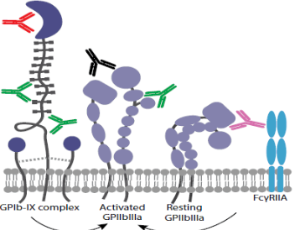Loading
Journal of Cellular Immunology
ISSN: 2689-2812

2020
Volume 2, Issue 1, p1-37
Articles published in this issue are Open Access and licensed under Creative Commons Attribution License (CC BY NC) where the readers can reuse, download, distribute the article in whole or part by mentioning proper credits to the authors.
What Can Go Wrong When Applying Immune Modulation Therapies to Target Persistent Bacterial Infections
Sofiya Micheva-Viteva, Elizabeth Hong-Geller
Persistence is a transient phenotypic adaptation that confers survival to a small percentage of cells (between 0.01 and 10%) in genetically identical bacterial populations. Nevertheless, persistence greatly affects the evolution of acquired drug resistance mutations by decreasing antibiotic efficacy and generating a reservoir of surviving cells that can contribute to the onset of chronic infectious disease.
J Cell Immunol, 2020, Volume 2, Issue 1, p1-5 | DOI: 10.33696/immunology.2.011
Is Platelet Desialylation a Novel Biomarker and Therapeutic Target in Immune Thrombocytopenia?
June Li, Jade A. Sullivan, Heyu Ni
Platelets are small anuclear cells shed from the megakaryocyte, at a rate of ~1011/day [1], maintaining a blood concentration of 100-450 x 109/L in healthy adults. As the second most abundant circulating cells, they are becoming increasingly recognized for their versatility and cross-talks in cancer, development, immunology among others.
J Cell Immunol, 2020, Volume 2, Issue 1, p6-14 | DOI: 10.33696/immunology.2.012
A Novel Class of RIP1 or RIP3 Dual Inhibitors
Ting Zhou, Bo Liu
Necroptosis is a form of programed necrosis mediated by receptor-interacting serine/threonine-protein kinase 1 (RIP1) and RIP3 and the subsequent phosphorylation of mixed lineage kinase domain-like protein (MLKL) [1-4]. Necroptosis has been implicated in multiple human diseases such as myocardial infarction, atherosclerosis, and abdominal aortic aneurysms (AAAs). Levels of RIP3 are elevated in the human tissues affected by these diseases.
J Cell Immunol, 2020, Volume 2, Issue 1, p15-17 | DOI: 10.33696/2689-2812.2.013
Recent Advances Show That Abnormal T-Regulatory Cell Function Perpetuates Chronic Inflammatory Arthritis
Charles J. Malemud
The principal mechanism governing immune central tolerance is regulated by T-cells that reside in a pathway wherein the death of immature T-cells is coupled to the development of CD4+ regulatory T (Treg) cells. In that regard, Treg cells undergo development in the thymus or peripheral tissues upon recognition of self-antigens.
J Cell Immunol, 2020, Volume 2, Issue 1, p18-22 | DOI: 10.33696/2689-2812.2.014
Tenofovir at the Crossroad of the Therapy and Prophylaxis of HIV and HBV Infections
Erik De Clercq
Tenofovir, alias (R)-PMPA, was first divulged as an anti- HIV agent in 1993 [1]. That it would in 2012, become the first antiretroviral agent, approved by the US FDA (Food and Drug Administration) to prevent HIV infection, could have been predicted from the findings of Tsai et al.
J Cell Immunol, 2020, Volume 2, Issue 1, p23-30 | DOI: 10.33696/immunology.2.015
CAR-T cell Goes on a Mathematical Model
Luciana Rodrigues Carvalho Barros, Brendon de Jesus Rodrigues, Regina C Almeida
Hundreds of new clinical trials were recently launched using chimeric antigen receptor-bearing T cells (CAR-T cell). Concentrated on hematological malignancies, with a 90% overall survival rate for 2 months on acute lymphoid leukemia (ALL-B) in young patients after two or more lines of therapy [1]. The most surprising results were the long-lasting effect of this therapy, resulting in more than 50% overall survival after a year follow-up.
J Cell Immunol, 2020, Volume 2, Issue 1, p31-37 | DOI: 10.33696/immunology.2.016
Recommended Articles
Chimeric Antigen Receptor CAR NK Cells Emerging Immunotherapy for the Treatment of Cancer
Although NK cells are recognized as effector lymphocytes of the innate immune system, they also regulate the adaptive immune response by releasing inflammatory cytokines and developing immunological memory. Unlike other lymphocytes such as T or B cells, NK cells do not express rearrangeable, antigen-specific receptors.
Deubiquitinase as Potential Targets for Cancer Immunotherapy
During the last few decades, immunotherapy is considered to be an important approach to help our immune system to fight various kinds of diseases, such as tumor. Sometimes, it works very well for some types of cancers, for example: bladder cancer, colorectal cancer, breast cancer and lymphoma.
Role of the Gut Microbiome in the Modulation of Cancer Immunotherapy Response
The gut microbiome or gut flora is a vast community of microorganisms such as bacteria, viruses, protozoa, and fungi that inhabit the digestive tract of the human and other animals [1,2]. In the human body, bacterial species colonize into the oral cavity, skin, vagina, and placenta, however, the largest population of microorganisms resides in the intestine.
Progression of Autoantibodies Anti-Gad and Anti-IA2 in Type 1A Diabetics Aged 5 to 21 Years in Cote d’Ivoire
Type 1A diabetes is an autoimmune disease, the final consequence of a slow and gradual process of ß-cell destruction of pancreatic islet Langerhans cells leading to ketoacidosis in the absence of treatment. This destruction of the β cells, responsible for the production of insulin, begins with the initiation of the autoimmune reaction triggered by certain environmental factors and, after several years of evolution, leads to the clinical signs of the disease when the mass of ß cells
CTLA-4 and PD-L1 or PD-1 Pathways: Immune Checkpoint Inhibitors and Cancer Immunotherapy
The immune system developed certain checks and balance to control or inhibit the reactivity against normal cells of the body. Uncontrolled immune responses to the non-self entities such as bacteria, viruses, parasites, or mutated self-antigens can cause an inflammatory reaction and autoimmune diseases.
Cancer Nanomedicine: Strategies to Enhance Tumor Delivery and Immunotherapy
Cancer nanomedicine was originally developed for more efficient delivery of chemotherapeutic agents into tumor, and has been extensively employed as a therapeutic for cancer treatment owing to its unique features in drug delivery, diagnosis and imaging, as well as the therapeutic nature of some nanomaterials themselves.
Targeting "Do Not Eat Me" Signal CD47 in Cancer Immunotherapy
Cells of the innate and adaptive arm of the immune system including macrophages, natural killer (NK) cells, neutrophils, T cells, and B cells, etc. are crucial for the maintenance of the body’s homeostatic balance and prevention of multiple diseases including cancer.
CAR-T cell Goes on a Mathematical Model
Hundreds of new clinical trials were recently launched using chimeric antigen receptor-bearing T cells (CAR-T cell). Concentrated on hematological malignancies, with a 90% overall survival rate for 2 months on acute lymphoid leukemia (ALL-B) in young patients after two or more lines of therapy [1]. The most surprising results were the long-lasting effect of this therapy, resulting in more than 50% overall survival after a year follow-up.
Autism – A Potential Autoimmune Disease Neurodegeneration-Induced Autoantibodies against Neural Proteins
Autism spectrum disorder (ASD) is a neurodevelopmental disorder characterized by difficulty in communication and repetitive behaviors [1]. ASD definition includes: atypical autism, high-functioning autism, and Asperger’s disorder. Individuals with ASD may have extraordinarily high IQ, normal intellectual abilities, or intellectual disability (ID), known as ASD with ID.
Using Intralipid to Improve Delivery of Anti-Cancer Nanodrugs: Effects on RES Clearance and Toxi city, EPR, and Immune Modulation
Encapsulation of therapeutic molecules (e.g., small molecule inhibitors, mRNA, siRNA, aptamers, etc.) into nanomaterials can improve the solubility and blood circulation of the drugs, alter their biodistribution, decrease their toxicities, overcome drug resistance, and facilitate their entry into target cells. The development of anti-cancer nanodrugs has been the focus of intense study for decades. Several anti-cancer nanodrugs have been approved for clinical use all over the world.
Immunotherapy in Pediatric Acute Lymphoblastic Leukemia
Leukemia is the most common childhood malignancy and is the most common cause of cancer death before the age of 20. Pediatric leukemia can be subdivided into acute versus chronic and lymphoid versus myeloid leukemia.
Small-molecule Interferon Inducers for Cancer Immunotherapy Targeting Non-T cell-inflamed Tumors
Since the discovery of escaping mechanism of tumor from negative immune regulation, the paradigm of drug discovery for anti-cancer agents has been dramatically shifted to cancer immunotherapy (e.g., dendritic cell therapy, CAR-T cell therapy, or antibody therapy) by stimulating patient’s immune system to treat cancer.
SHP2 Inhibition as a Promising Anti-cancer Therapy: Function in Tumor Cell Signaling and Immune Modulation
The SHP2 phosphatase consists of one protein tyrosine phosphatase catalytic domain (PTP domain), two tandem Src homology 2 (SH2) domains (N-SH2 and C-SH2), and a C-terminal tail with two tyrosine phosphorylation sites (Tyr542 and Tyr580)
Neurocysticercosis: Autoantibodies, Another Cog in the Wheel of Its Variable Pathogenicity
Neurological diseases are a major cause of disability and the second cause of death today. This reality has stimulated the search for predictive biomarkers facilitating early diagnosis and the design of appropriate treatments.
Second Generation Platelet Concentrates - L-PRF (Fibrin Rich in Platelets and Leukocytes) and Its Derivatives (A-PRF, I-PRF)-: Morphological Characteristics to be Used in Modern Regenerative Surgery. Experimental Research
Platelet preparations (PDPs) have gained success, mainly due to their high concentrations of biologically active molecules, such as growth factors and cytokines, which play an important role in tissue repair and reconstruction. Recent knowledge shows that platelets can play a new role in tissue reproduction and vascular restoration, as well as being the protagonists of inflammatory processes and immune system responses. They release bio-active proteins and other active ingredients that can affect a number of phenomena that promote cell consumption, growth and transformation (growth factors).
Gemcitabine in the Era of Cancer Immunotherapy
Gemcitabine is a synthetic pyrimidine nucleoside analogue which is administered intravenously as a chemotherapeutic to treat numerous cancers. Gemcitabine requires transport into cells and activation by phosphorylation, the resulting gemcitabine triphosphate is incorporated into newly synthesized DNA during cell division, inhibiting further DNA synthesis and causing cell death. Gemcitabine is used to treat cancers including those of the pancreas, lung, breast, colon, and ovary either as first or second line treatments as a single agent or in combination.
CART Cells: A New Dawn in Cancer Immunotherapy
Over the last 10 to 15 years the treatment of patients with hematologic malignancies has seen the blossom of a large number of new agents and even new treatment strategies. Monoclonal antibodies (MoAb), TKI inhibitors, checkpoint inhibitors have been introduced in the daily clinical practice and contributed significantly to the improvement of the outcome of hematologic patients. Along with the development of these new drugs, cellular therapies, namely chimeric antigen receptor-engineered T (CART) cells, have revolutionized the therapeutic paradigm of patients with B-cell lymphoid malignancies and acute lymphoblastic leukemia (ALL).
OGR1-a Novel Modulator Target of Tumor Immunotherapy
Tumors mainly utilize glucose to promote aerobic glycolysis for their survival (Warburg effect). The highly glycolytic environment is not suitable for the survival and function of effector T cells, and leads to the decline of antitumor immunity.
CRISPR Taking the Front Seat in Immunotherapy
CRISPR (clustered regularly interspaced short palindromic repeats) technology has dramatically simplified genome editing and is widely applicable in both basic research and therapeutic areas.
Autoantibodies in Overlapping Systemic Sclerosis and Primary Biliary Cirrhosis Autoimmune Diseases
Anticentromere antibodies (ACA) are considered an important diagnostic marker of scleroderma or systemic sclerosis (SSc), being CENP-B the major centromere auto-antigen recognized by sera from SSc patients. However, ACA can also be detected in patients with other connective tissue diseases.
About Scientific Archives
Scientific Archives is a global publisher initiated with the mission of ensuring equal opportunity for accessing science to research community all over the world. Spreading research findings with great relevance to all channels without any barrier is our goal. We want to overcome the challenges of Open Access with ensured quality and transparency.
